Challenges and Strategies: Study Skills in Higher Education
VerifiedAdded on 2022/02/07
|6
|1453
|31
Essay
AI Summary
This essay delves into the critical role of study skills in higher education, emphasizing the importance of effective communication between students and teachers. It addresses the listening challenges students face, such as fast lecture speeds, complex sentence structures, and the use of irrelevant words, which can hinder comprehension. The essay then presents strategies to improve listening skills, including teachers getting to know their students, making the classroom engaging, and controlling the pace of lectures. It also includes personal experiences, highlighting challenges like monotonous classes, rapid delivery rates, and lack of interaction, and how these were overcome through strategies such as breaks, providing hand notes, and encouraging interaction. The conclusion underscores the need for both students and teachers to actively participate in creating an environment conducive to effective learning.
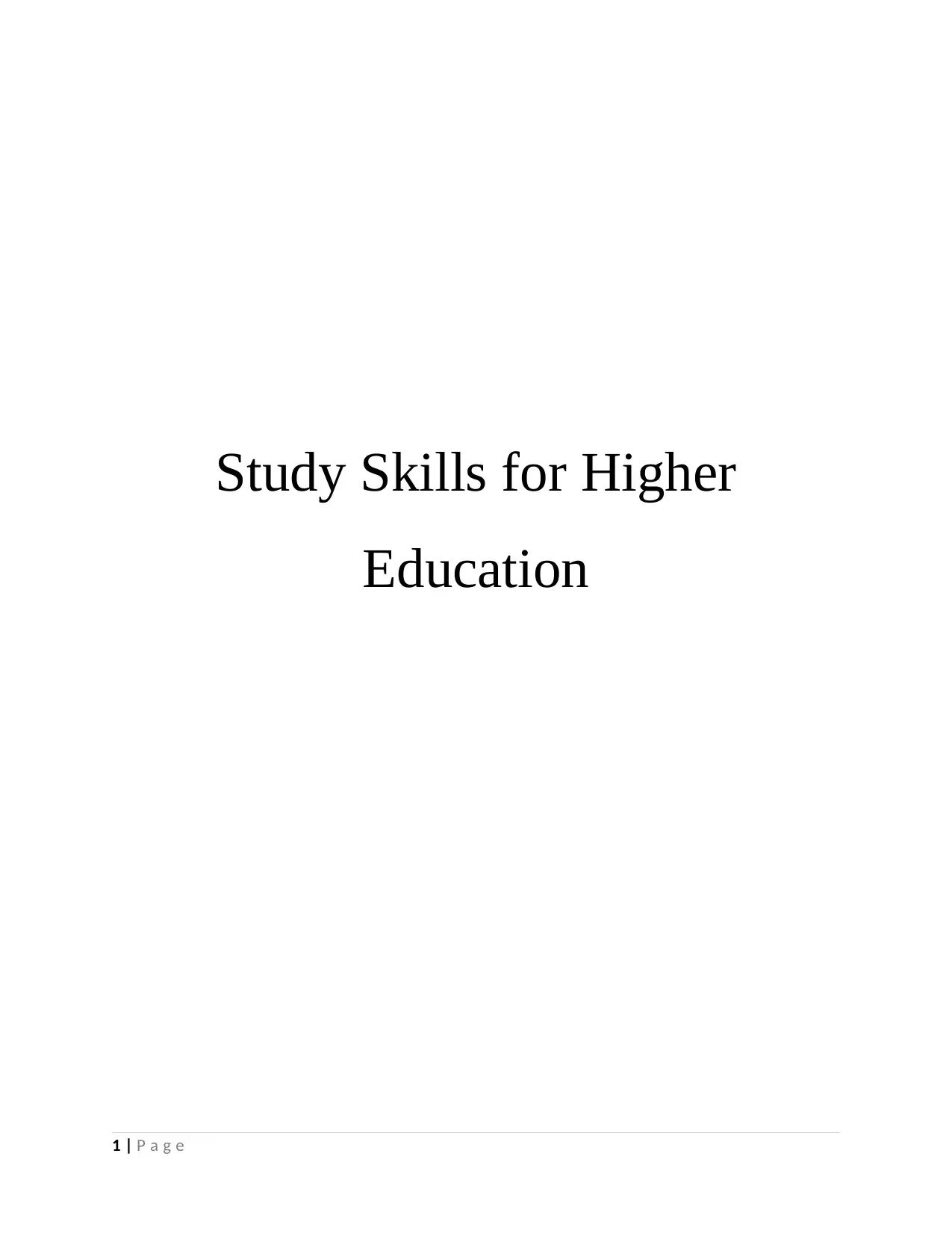
Study Skills for Higher
Education
1 | P a g e
Education
1 | P a g e
Paraphrase This Document
Need a fresh take? Get an instant paraphrase of this document with our AI Paraphraser
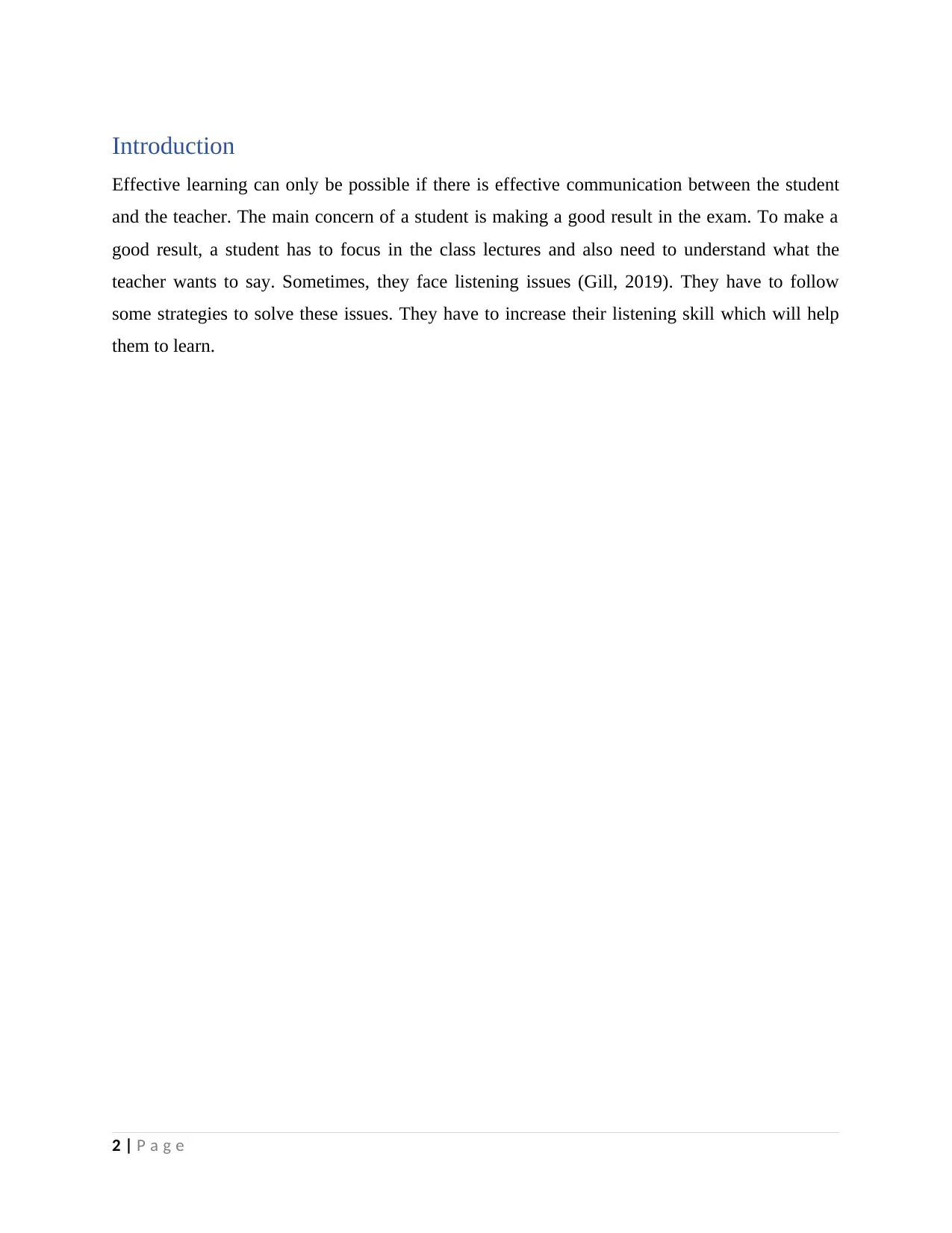
Introduction
Effective learning can only be possible if there is effective communication between the student
and the teacher. The main concern of a student is making a good result in the exam. To make a
good result, a student has to focus in the class lectures and also need to understand what the
teacher wants to say. Sometimes, they face listening issues (Gill, 2019). They have to follow
some strategies to solve these issues. They have to increase their listening skill which will help
them to learn.
2 | P a g e
Effective learning can only be possible if there is effective communication between the student
and the teacher. The main concern of a student is making a good result in the exam. To make a
good result, a student has to focus in the class lectures and also need to understand what the
teacher wants to say. Sometimes, they face listening issues (Gill, 2019). They have to follow
some strategies to solve these issues. They have to increase their listening skill which will help
them to learn.
2 | P a g e
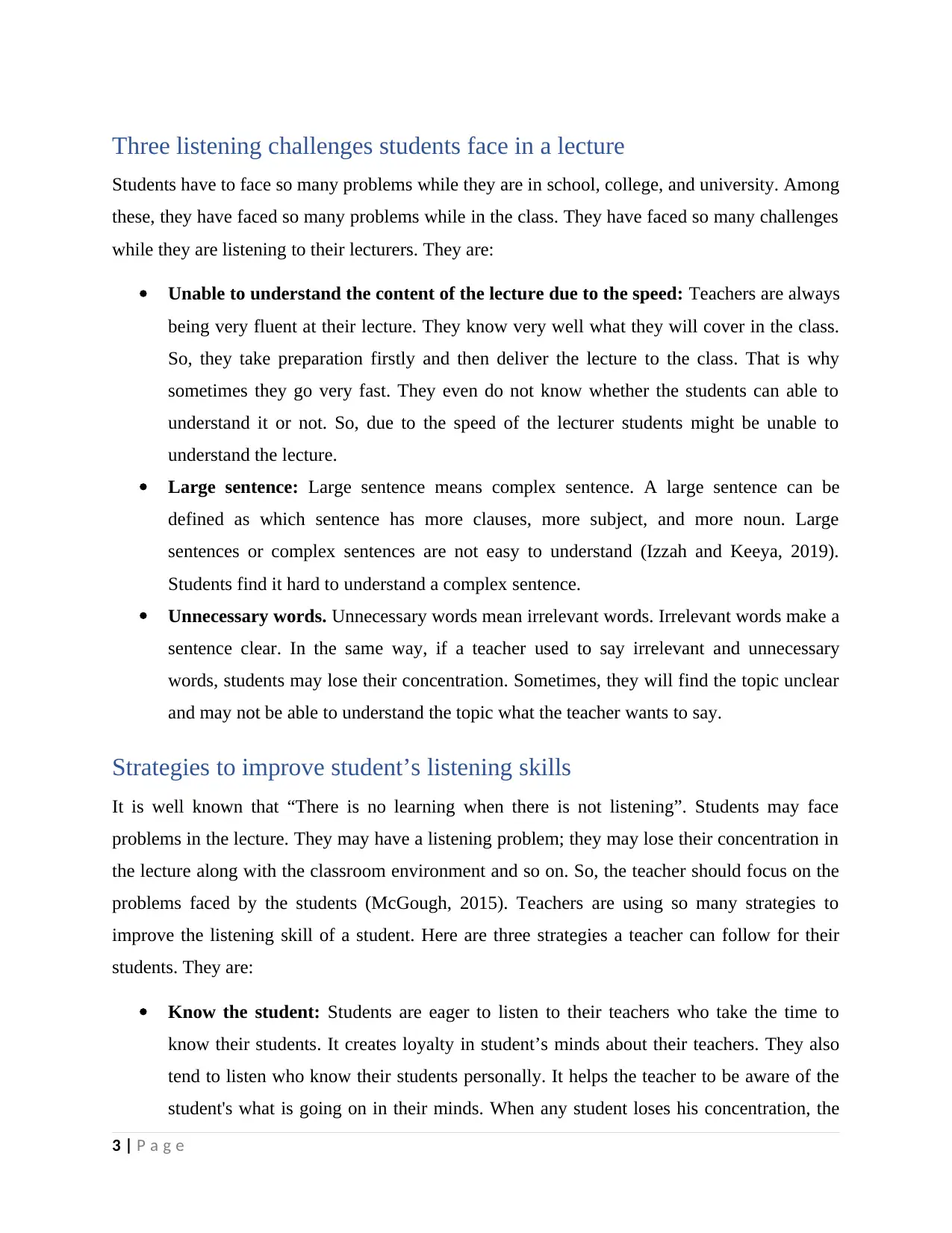
Three listening challenges students face in a lecture
Students have to face so many problems while they are in school, college, and university. Among
these, they have faced so many problems while in the class. They have faced so many challenges
while they are listening to their lecturers. They are:
Unable to understand the content of the lecture due to the speed: Teachers are always
being very fluent at their lecture. They know very well what they will cover in the class.
So, they take preparation firstly and then deliver the lecture to the class. That is why
sometimes they go very fast. They even do not know whether the students can able to
understand it or not. So, due to the speed of the lecturer students might be unable to
understand the lecture.
Large sentence: Large sentence means complex sentence. A large sentence can be
defined as which sentence has more clauses, more subject, and more noun. Large
sentences or complex sentences are not easy to understand (Izzah and Keeya, 2019).
Students find it hard to understand a complex sentence.
Unnecessary words. Unnecessary words mean irrelevant words. Irrelevant words make a
sentence clear. In the same way, if a teacher used to say irrelevant and unnecessary
words, students may lose their concentration. Sometimes, they will find the topic unclear
and may not be able to understand the topic what the teacher wants to say.
Strategies to improve student’s listening skills
It is well known that “There is no learning when there is not listening”. Students may face
problems in the lecture. They may have a listening problem; they may lose their concentration in
the lecture along with the classroom environment and so on. So, the teacher should focus on the
problems faced by the students (McGough, 2015). Teachers are using so many strategies to
improve the listening skill of a student. Here are three strategies a teacher can follow for their
students. They are:
Know the student: Students are eager to listen to their teachers who take the time to
know their students. It creates loyalty in student’s minds about their teachers. They also
tend to listen who know their students personally. It helps the teacher to be aware of the
student's what is going on in their minds. When any student loses his concentration, the
3 | P a g e
Students have to face so many problems while they are in school, college, and university. Among
these, they have faced so many problems while in the class. They have faced so many challenges
while they are listening to their lecturers. They are:
Unable to understand the content of the lecture due to the speed: Teachers are always
being very fluent at their lecture. They know very well what they will cover in the class.
So, they take preparation firstly and then deliver the lecture to the class. That is why
sometimes they go very fast. They even do not know whether the students can able to
understand it or not. So, due to the speed of the lecturer students might be unable to
understand the lecture.
Large sentence: Large sentence means complex sentence. A large sentence can be
defined as which sentence has more clauses, more subject, and more noun. Large
sentences or complex sentences are not easy to understand (Izzah and Keeya, 2019).
Students find it hard to understand a complex sentence.
Unnecessary words. Unnecessary words mean irrelevant words. Irrelevant words make a
sentence clear. In the same way, if a teacher used to say irrelevant and unnecessary
words, students may lose their concentration. Sometimes, they will find the topic unclear
and may not be able to understand the topic what the teacher wants to say.
Strategies to improve student’s listening skills
It is well known that “There is no learning when there is not listening”. Students may face
problems in the lecture. They may have a listening problem; they may lose their concentration in
the lecture along with the classroom environment and so on. So, the teacher should focus on the
problems faced by the students (McGough, 2015). Teachers are using so many strategies to
improve the listening skill of a student. Here are three strategies a teacher can follow for their
students. They are:
Know the student: Students are eager to listen to their teachers who take the time to
know their students. It creates loyalty in student’s minds about their teachers. They also
tend to listen who know their students personally. It helps the teacher to be aware of the
student's what is going on in their minds. When any student loses his concentration, the
3 | P a g e
⊘ This is a preview!⊘
Do you want full access?
Subscribe today to unlock all pages.

Trusted by 1+ million students worldwide
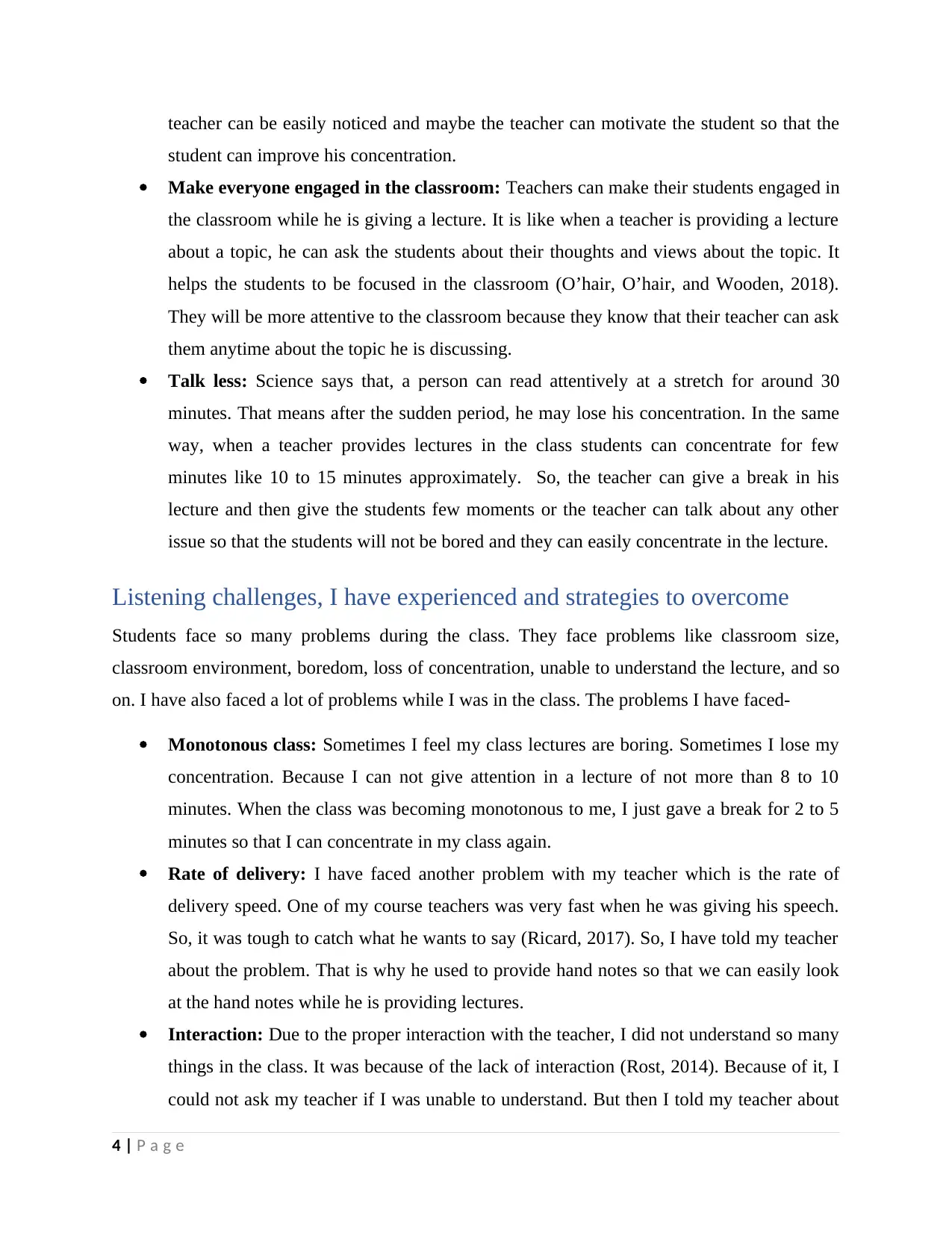
teacher can be easily noticed and maybe the teacher can motivate the student so that the
student can improve his concentration.
Make everyone engaged in the classroom: Teachers can make their students engaged in
the classroom while he is giving a lecture. It is like when a teacher is providing a lecture
about a topic, he can ask the students about their thoughts and views about the topic. It
helps the students to be focused in the classroom (O’hair, O’hair, and Wooden, 2018).
They will be more attentive to the classroom because they know that their teacher can ask
them anytime about the topic he is discussing.
Talk less: Science says that, a person can read attentively at a stretch for around 30
minutes. That means after the sudden period, he may lose his concentration. In the same
way, when a teacher provides lectures in the class students can concentrate for few
minutes like 10 to 15 minutes approximately. So, the teacher can give a break in his
lecture and then give the students few moments or the teacher can talk about any other
issue so that the students will not be bored and they can easily concentrate in the lecture.
Listening challenges, I have experienced and strategies to overcome
Students face so many problems during the class. They face problems like classroom size,
classroom environment, boredom, loss of concentration, unable to understand the lecture, and so
on. I have also faced a lot of problems while I was in the class. The problems I have faced-
Monotonous class: Sometimes I feel my class lectures are boring. Sometimes I lose my
concentration. Because I can not give attention in a lecture of not more than 8 to 10
minutes. When the class was becoming monotonous to me, I just gave a break for 2 to 5
minutes so that I can concentrate in my class again.
Rate of delivery: I have faced another problem with my teacher which is the rate of
delivery speed. One of my course teachers was very fast when he was giving his speech.
So, it was tough to catch what he wants to say (Ricard, 2017). So, I have told my teacher
about the problem. That is why he used to provide hand notes so that we can easily look
at the hand notes while he is providing lectures.
Interaction: Due to the proper interaction with the teacher, I did not understand so many
things in the class. It was because of the lack of interaction (Rost, 2014). Because of it, I
could not ask my teacher if I was unable to understand. But then I told my teacher about
4 | P a g e
student can improve his concentration.
Make everyone engaged in the classroom: Teachers can make their students engaged in
the classroom while he is giving a lecture. It is like when a teacher is providing a lecture
about a topic, he can ask the students about their thoughts and views about the topic. It
helps the students to be focused in the classroom (O’hair, O’hair, and Wooden, 2018).
They will be more attentive to the classroom because they know that their teacher can ask
them anytime about the topic he is discussing.
Talk less: Science says that, a person can read attentively at a stretch for around 30
minutes. That means after the sudden period, he may lose his concentration. In the same
way, when a teacher provides lectures in the class students can concentrate for few
minutes like 10 to 15 minutes approximately. So, the teacher can give a break in his
lecture and then give the students few moments or the teacher can talk about any other
issue so that the students will not be bored and they can easily concentrate in the lecture.
Listening challenges, I have experienced and strategies to overcome
Students face so many problems during the class. They face problems like classroom size,
classroom environment, boredom, loss of concentration, unable to understand the lecture, and so
on. I have also faced a lot of problems while I was in the class. The problems I have faced-
Monotonous class: Sometimes I feel my class lectures are boring. Sometimes I lose my
concentration. Because I can not give attention in a lecture of not more than 8 to 10
minutes. When the class was becoming monotonous to me, I just gave a break for 2 to 5
minutes so that I can concentrate in my class again.
Rate of delivery: I have faced another problem with my teacher which is the rate of
delivery speed. One of my course teachers was very fast when he was giving his speech.
So, it was tough to catch what he wants to say (Ricard, 2017). So, I have told my teacher
about the problem. That is why he used to provide hand notes so that we can easily look
at the hand notes while he is providing lectures.
Interaction: Due to the proper interaction with the teacher, I did not understand so many
things in the class. It was because of the lack of interaction (Rost, 2014). Because of it, I
could not ask my teacher if I was unable to understand. But then I told my teacher about
4 | P a g e
Paraphrase This Document
Need a fresh take? Get an instant paraphrase of this document with our AI Paraphraser
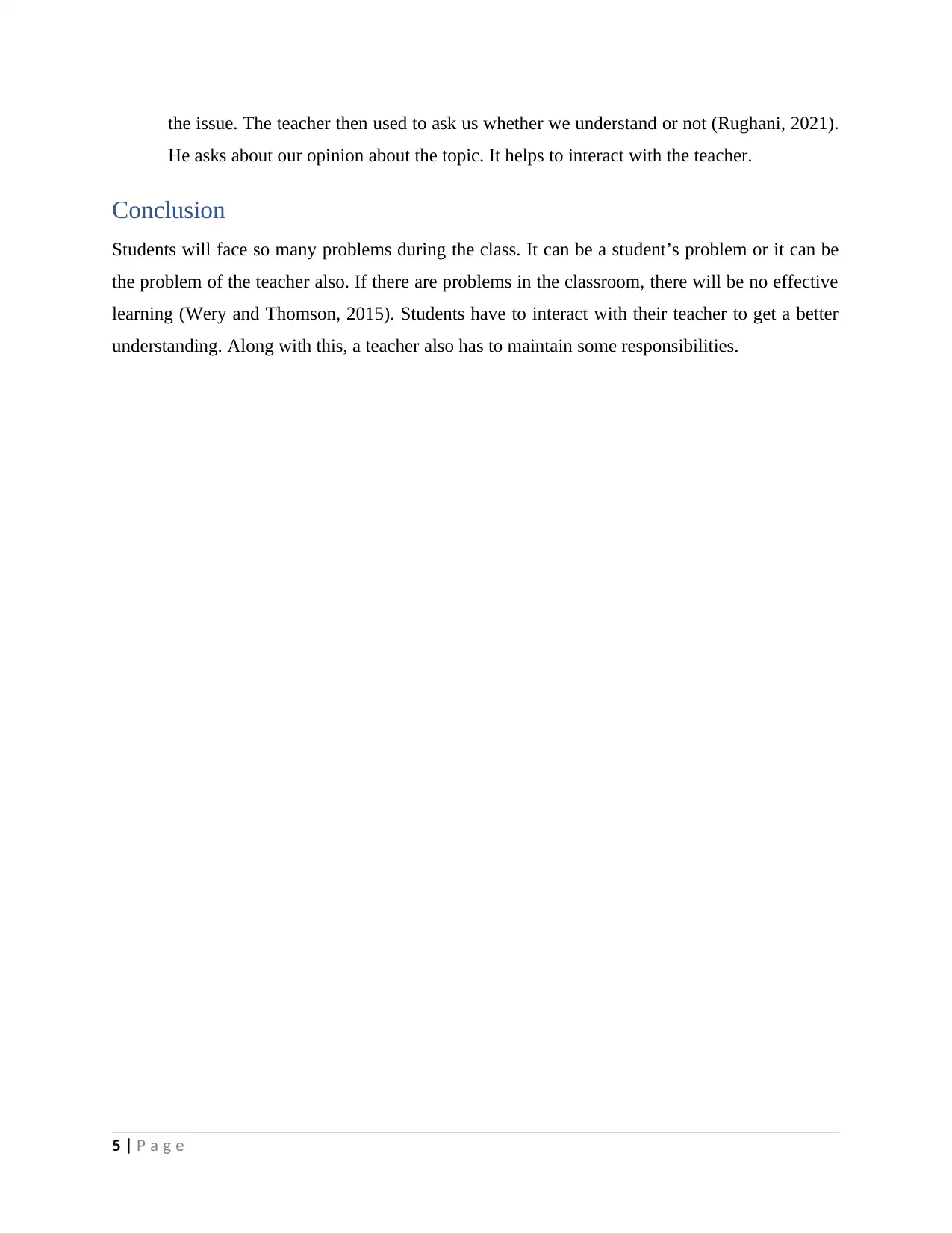
the issue. The teacher then used to ask us whether we understand or not (Rughani, 2021).
He asks about our opinion about the topic. It helps to interact with the teacher.
Conclusion
Students will face so many problems during the class. It can be a student’s problem or it can be
the problem of the teacher also. If there are problems in the classroom, there will be no effective
learning (Wery and Thomson, 2015). Students have to interact with their teacher to get a better
understanding. Along with this, a teacher also has to maintain some responsibilities.
5 | P a g e
He asks about our opinion about the topic. It helps to interact with the teacher.
Conclusion
Students will face so many problems during the class. It can be a student’s problem or it can be
the problem of the teacher also. If there are problems in the classroom, there will be no effective
learning (Wery and Thomson, 2015). Students have to interact with their teacher to get a better
understanding. Along with this, a teacher also has to maintain some responsibilities.
5 | P a g e
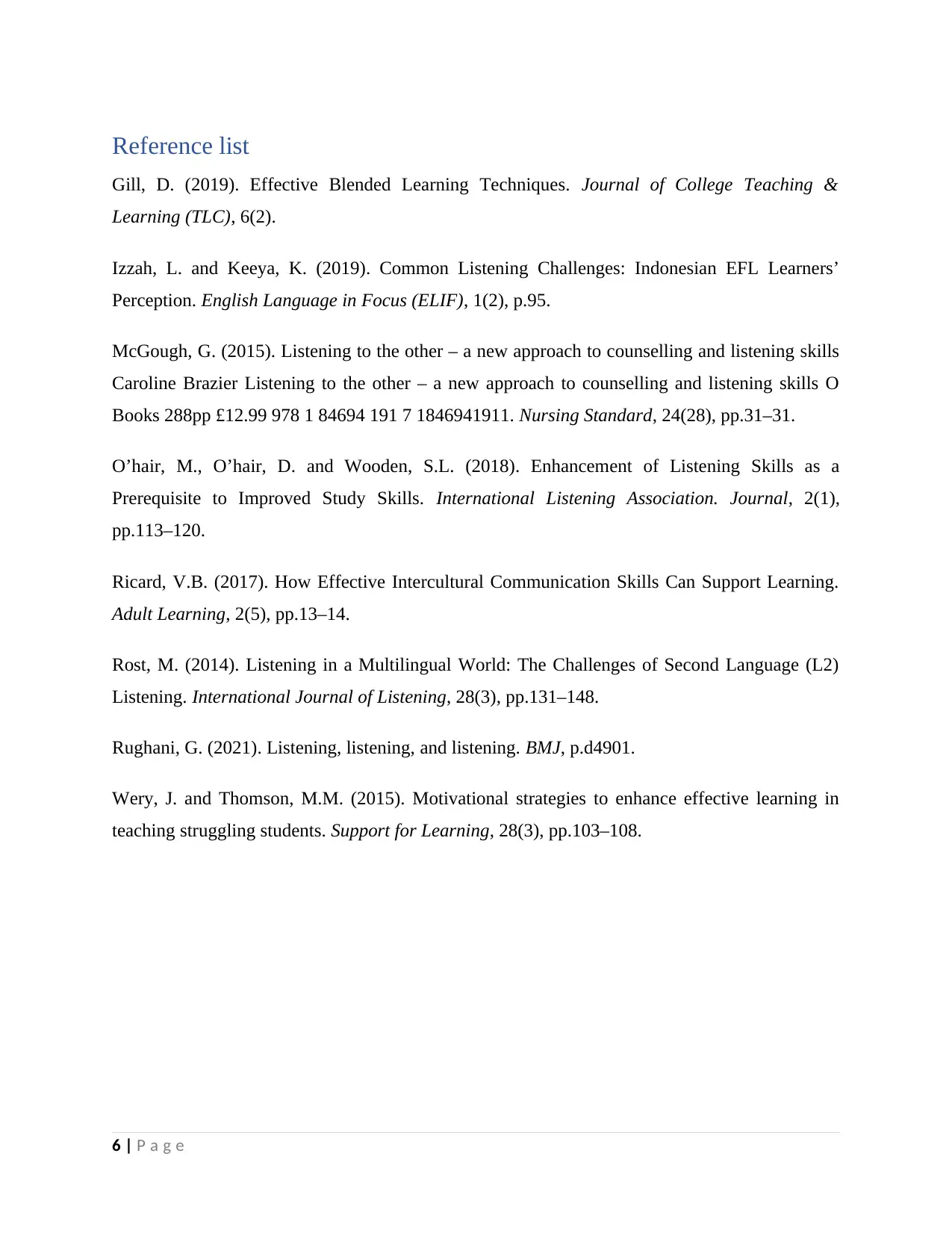
Reference list
Gill, D. (2019). Effective Blended Learning Techniques. Journal of College Teaching &
Learning (TLC), 6(2).
Izzah, L. and Keeya, K. (2019). Common Listening Challenges: Indonesian EFL Learners’
Perception. English Language in Focus (ELIF), 1(2), p.95.
McGough, G. (2015). Listening to the other – a new approach to counselling and listening skills
Caroline Brazier Listening to the other – a new approach to counselling and listening skills O
Books 288pp £12.99 978 1 84694 191 7 1846941911. Nursing Standard, 24(28), pp.31–31.
O’hair, M., O’hair, D. and Wooden, S.L. (2018). Enhancement of Listening Skills as a
Prerequisite to Improved Study Skills. International Listening Association. Journal, 2(1),
pp.113–120.
Ricard, V.B. (2017). How Effective Intercultural Communication Skills Can Support Learning.
Adult Learning, 2(5), pp.13–14.
Rost, M. (2014). Listening in a Multilingual World: The Challenges of Second Language (L2)
Listening. International Journal of Listening, 28(3), pp.131–148.
Rughani, G. (2021). Listening, listening, and listening. BMJ, p.d4901.
Wery, J. and Thomson, M.M. (2015). Motivational strategies to enhance effective learning in
teaching struggling students. Support for Learning, 28(3), pp.103–108.
6 | P a g e
Gill, D. (2019). Effective Blended Learning Techniques. Journal of College Teaching &
Learning (TLC), 6(2).
Izzah, L. and Keeya, K. (2019). Common Listening Challenges: Indonesian EFL Learners’
Perception. English Language in Focus (ELIF), 1(2), p.95.
McGough, G. (2015). Listening to the other – a new approach to counselling and listening skills
Caroline Brazier Listening to the other – a new approach to counselling and listening skills O
Books 288pp £12.99 978 1 84694 191 7 1846941911. Nursing Standard, 24(28), pp.31–31.
O’hair, M., O’hair, D. and Wooden, S.L. (2018). Enhancement of Listening Skills as a
Prerequisite to Improved Study Skills. International Listening Association. Journal, 2(1),
pp.113–120.
Ricard, V.B. (2017). How Effective Intercultural Communication Skills Can Support Learning.
Adult Learning, 2(5), pp.13–14.
Rost, M. (2014). Listening in a Multilingual World: The Challenges of Second Language (L2)
Listening. International Journal of Listening, 28(3), pp.131–148.
Rughani, G. (2021). Listening, listening, and listening. BMJ, p.d4901.
Wery, J. and Thomson, M.M. (2015). Motivational strategies to enhance effective learning in
teaching struggling students. Support for Learning, 28(3), pp.103–108.
6 | P a g e
⊘ This is a preview!⊘
Do you want full access?
Subscribe today to unlock all pages.

Trusted by 1+ million students worldwide
1 out of 6
Related Documents
Your All-in-One AI-Powered Toolkit for Academic Success.
+13062052269
info@desklib.com
Available 24*7 on WhatsApp / Email
![[object Object]](/_next/static/media/star-bottom.7253800d.svg)
Unlock your academic potential
Copyright © 2020–2025 A2Z Services. All Rights Reserved. Developed and managed by ZUCOL.





